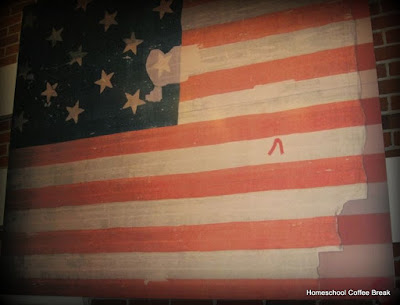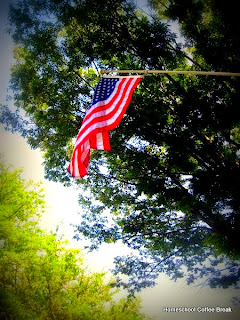Happy Flag Day!
In honor of the 239th anniversary of the Flag Act of 1777, here are a few facts about the flag of the United States.
The Design
On June 14, 1777, the Second Continental Congress passed a resolution called the Flag Act of 1777. This resolution established an official flag for the new nation. It specified that the flag . . .
be made of thirteen stripes, alternate red and white; that the union be thirteen stars, white in a blue field, representing a new Constellation.
The new national flag became known as the Stars and Stripes, and was based on the "Grand Union" flag, which was a banner carried by the Continental Army in 1776 that was thirteen red and white stripes.
The design stayed the same for about twenty years. In 1794, two stars and two stripes were added when Kentucky and Vermont were admitted into the Union. New stars and stripes were added to represent more new additions, until 1818, when Congress enacted a law restoring the original thirteen stripes, and stating that only stars be added to represent new states. The new stars were to be added ceremonially each July 4th in years that new states were admitted.
The U.S. Army issues a reference guide of acceptable shades to be used in local, state, and national flags; and it specifies the exact shades of white, "Old Glory Red", and "Old Glory Blue" to be used in an authentic American flag. However, many flag manufacturers use the more easily processed Pantone matching shades in flags intended for the mass market.
The History
According to legend, the original design was created by Philadelphia seamstress Betsy Ross, at the request of General George Washington. Historians have been unable to conclusively prove (or disprove!) the story, but it's fairly commonly accepted to be true. Whether you believe the claim or not, Betsy Ross House in Philadelphia is a popular tourist attraction and very interesting!
| Betsy Ross House in Philadelphia |
The version of the flag that inspired Francis Scott Key to write the poem known as The Star-Spangled Banner was the 15-salthtar (that's flag-speak for stars), 15-stripe flag. It was flying over Fort McHenry during the War of 1812.
(For more, see From the High School Lesson Book - The Star-Spangled Banner)
 |
| The Star-spangled Banner displayed at Fort McHenry. |
| The (new) flag flying over Fort McHenry. |
The first Flag Day observance was held on the 100th anniversary of the flag's adoption, on June 14th, 1877. Congress instructed that the U.S. flag be flown from all public buildings in the country. In the years following, several states continued to observe the anniversary, and in 1949 Congress officially designated June 14th as Flag Day.
Since 1949, Flag Day has been a national holiday, but it is not a federal holiday. What's the difference? National holidays celebrate independence or another important occasion in the nation's history, but federal holidays are also public holidays and government offices are closed. So sorry, you won't generally get a day off work or school for Flag Day! Only one state observes Flag Day as an official holiday - Pennsylvania.
The Right Way to Display the Flag
Patriotic Americans are naturally very offended when the flag is disrespected by people burning or stomping on it. But some of the first measures to protect the flag were more concerned with its being used in advertising, which 19th century lawmakers considered treating it with contempt. Many of the first statutes passed restricted the use of the flag on commercial products.
The U.S. Code provides a guide for all handling and display of the flag, but does not impose penalties for misuse of the flag. That is left to the states, and each has its own flag laws. The Flag Code formalizes some traditional respect shown to the flag, and specifies ways in which the flag is not to be used. For example, the flag should never be dipped to any person or thing; it should not be used as drapery, or as part of a costume or athletic uniform; it should not be used for any advertising purpose; and should not be imprinted or impressed on anything intended to be discarded after temporary use. (It's misused a lot, isn't it? Although I guess it's usually stylized on clothing and things like napkins and paper plates, but still. Personally, I don't feel so good about using paper plates and napkins with a flag design on them.) When lowered, no part of the flag should touch the ground or any other object; and when a flag is so worn that it's no longer fit as a symbol of our country, it should be destroyed by burning in a dignified manner. American Legion Posts and other organizations conduct dignified flag burning ceremonies, often on Flag Day, so if you have a torn or badly faded flag that should be retired, try contacting the Legion for information.
There are clear guidelines for how the flag is to be flown as well. It should be flown with the union at the peak of the staff unless it is being flown at half-staff. When flown with other flags, it must always be in the position of honor - no other flag should be above or larger than the US flag. When the flag passes in a procession, all should face the flag and salute - those in uniform with a formal salute, and those not in uniform with right hand over the heart and head covering removed. During the Pledge of Allegiance and National Anthem, citizens should all remain at attention and salute.
 |
| Photo courtesy: CAP |
For more details on Standards of Respect and Flag Etiquette, visit USFlag.org. For more information on how to display the flag correctly, visit USHistory.org.
Also celebrating today:
The U.S. Army was established in 1775 when Congress formally authorized the enlistment of soldiers to fight in what became known as the Continental Army.
Happy 241st Birthday to the U.S. Army! And thank you again to all those who serve.
This post is part of a Coffee & Conversation Link Party at PatAndCandy.com - Join us!

This post is part of a Coffee & Conversation Link Party at PatAndCandy.com - Join us!
Don't miss a coffee break! Subscribe to Homeschool Coffee Break by Email!
©2006-2016 Homeschool Coffee Break. All rights reserved. All text, photographs, artwork, and other content may not be reproduced or transmitted in any form without the written consent of the author. http://kympossibleblog.blogspot.com/















































3 comments:
well, I learned a few things. :)
Good round up of flag facts. We learned a lot of them during the Memorial Day study I did with my boys last month.
I didn't know all of that! I do think that the flag is used for decoration and not in the correct way often.
Post a Comment
I love comments! It's like visiting over a virtual cup of coffee.